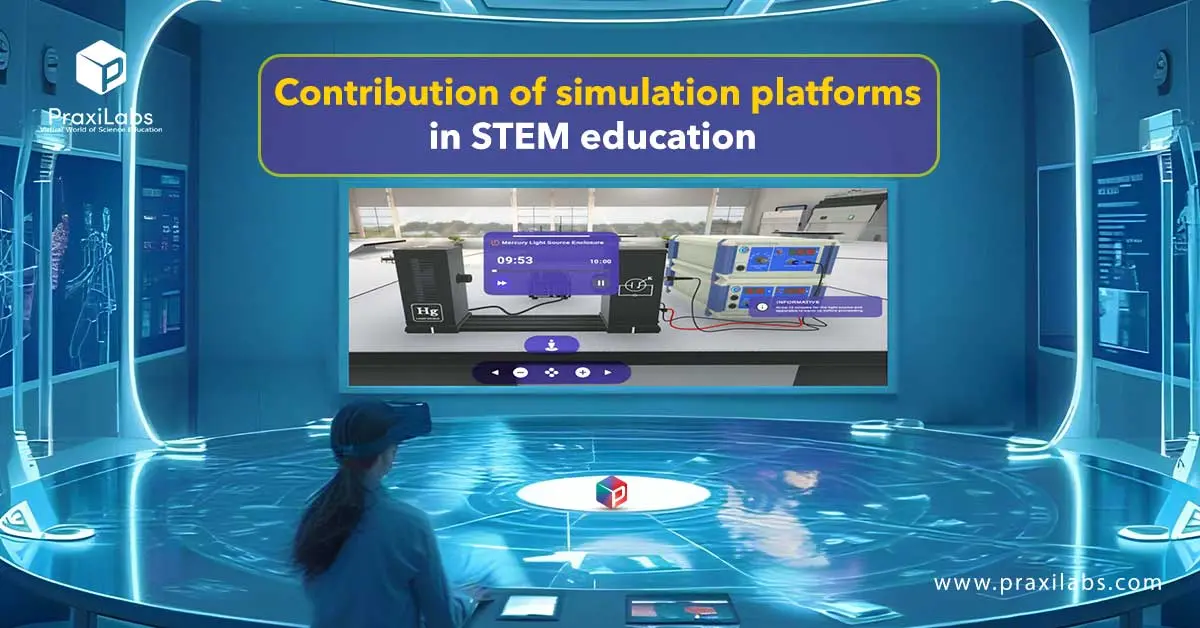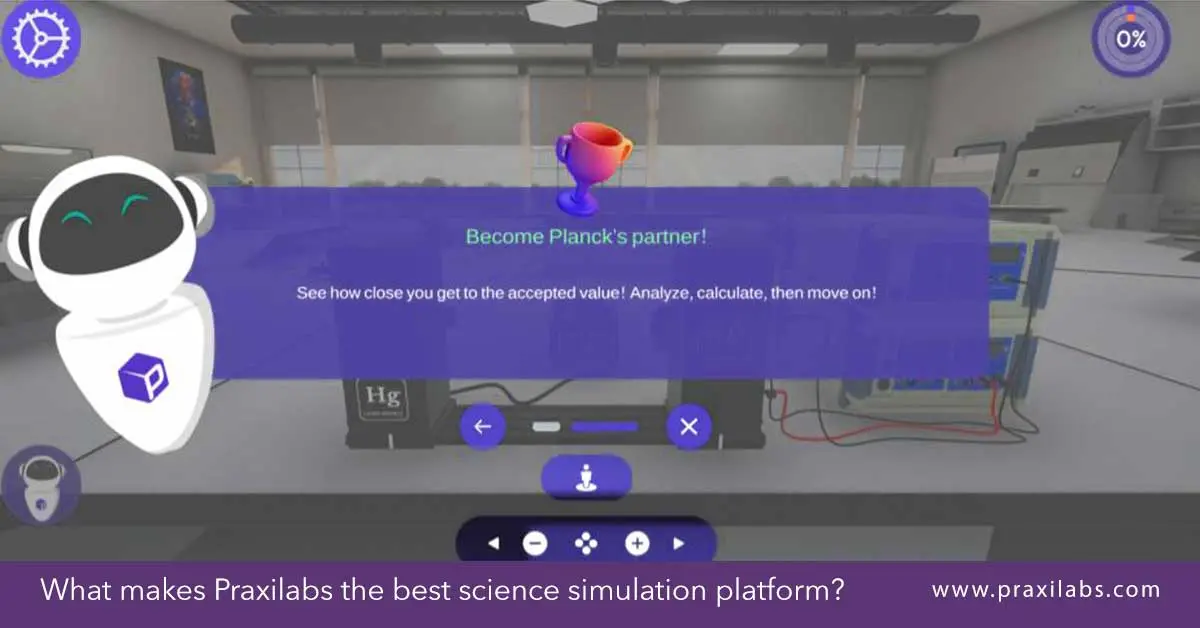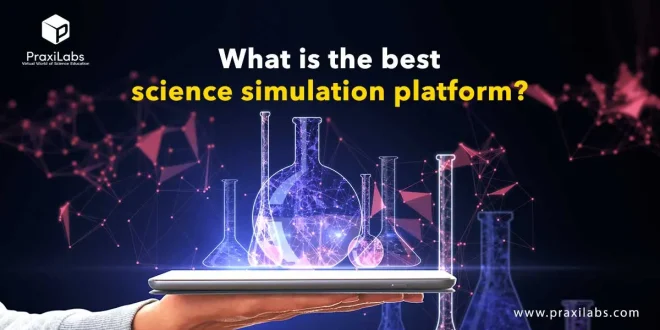Last Updated on October 2, 2025 by Muhamed Elmesery
Choosing the best science simulation platform isn’t about flashy features—it’s about finding a tool that makes complex concepts clear, engaging, and accessible for every learner. With so many options available, the right platform can transform STEM education by bringing experiments to life anytime, anywhere.
In this blog post, we will learn more about simulation platforms, types of simulation platforms, common use cases of them, contribution of simulation platforms in STEM education, how to choose the right simulation platform, and what makes Praxilabs the best science simulation platform.
Table of Contents
What is a simulation platform?
A simulation platform is a software environment that uses computer-based models to replicate the behavior of real-world systems or abstract concepts. It allows users to observe and understand a specific process without actually performing it!
One of the most famous and influential types of virtual simulations platforms is remote learning platforms and science simulation platforms that simulate real experiences in various fields such as physics, chemistry, and biology, providing a wide range of features such as flexible learning, accessibility anytime and anywhere, and repetition.
Types of simulation platforms
Here’s a comparison of the types of simulation platforms:
| Type of Simulation Platform | Description | Strengths | Limitations |
| Web-Based Simulations | Run directly in a browser, no installation required. Accessible on most devices | Easy access, scalable, device-friendly, cost-effective | Limited offline use, dependent on internet speed |
| Desktop Applications | Installed software with advanced capabilities, often offline-ready | Powerful processing, customizable, offline availability | Requires installation, higher hardware demands, licensing costs |
| VR/AR Simulations | Immersive platforms using Virtual or Augmented Reality headsets | High engagement, real-world immersion, kinesthetic learning | Expensive hardware, accessibility barriers, motion sickness for some |
| Mobile Simulation Apps | Apps optimized for smartphones and tablets for learning on the go | Portability, user-friendly, accessible for students | Limited complexity, smaller screen constraints |
| Game-Based Simulations | Simulations with gamification elements (points, levels, storytelling) | Motivates learners, fun, enhances retention | May oversimplify complex concepts |
| Cloud-Based Simulation Platforms | Hosted on cloud servers, often offering collaboration and real-time updates | Collaboration, scalability, no local storage limits | Requires strong internet, subscription fees |
Common use cases of a simulation platform
Science virtual labs are one of the most common use cases of a simulation platform.
They are considered one of the most important applications of e-learning in educational and research institutions, as they provide students with the opportunity to conduct experiments without being exposed to any type of risk and without the presence of a human supervisor, through computer applications in various fields of science.
They also save a lot of time and effort for students and teachers, allowing them to conduct and prepare experiments anywhere and anytime.
Additionally, virtual laboratories provide protection for students from handling hazardous chemicals or electrical equipment directly. On the institutional side, they have saved a lot of money that would have been wasted on maintaining devices and equipment or purchasing materials necessary for conducting various experiments.

Contribution of simulation platforms in STEM education
Online simulation platforms have become a transformative force in STEM (Science, Technology, Engineering, and Mathematics) education, offering new ways for students to engage with complex concepts.
Effective learning requires attention. The immersive and interactive 3D virtual STEM simulation platforms go a long way in providing students with the tools that allow for more focus, attention, and engagement. Students remain interested and engaged while staying alert and absorbing the information more easily.
The 3D science experiments provided by simulation platforms enhance students’ understanding and knowledge through virtual hands-on experience of what they’ve learned.
The goal of using platform simulation in STEM education is to understand the foundations and complex scientific theories that may be difficult to study experimentally or theoretically in a real laboratory. This also addresses the problems faced by students and educational institutions in conducting experiments in a real lab, such as:-
- Safety and security risks.
- High costs.
- Ethical challenges.
- Limited access for students.
- Lack of student interaction and interest.
- High failure rates among students.
- Inability to accommodate the large and increasing number of students.
- Excessive time constraints faced by teachers and professors.
We can say that simulation platforms democratize STEM education by making advanced experiments more affordable, scalable, interactive, and engaging, equipping students with both theoretical knowledge and practical skills for the future.
How to choose the suitable simulation platform?
Here’s a step-by-step guide on how to choose the suitable simulation platform:
Step 1: Identify and define your learning objectives and goals (what will your users learn by using virtual simulations).
Step 2: Choose an appropriate simulation platform that provides virtual lab simulations aligned with your goals and learning objectives.
Step 3: Evaluate the platform based on its scalability, features, ease of use, and compatibility with your existing systems
Step 4: Familiarize yourself with the simulation platform you have chosen, try it yourself, and prepare any learning materials you may need.
Step 5: Consider the cost, licensing options, and vendor support to select the most suitable platform for your needs.
Step 6: Provide access and instructions to your users and contributors. Tell them:
- Where to find the simulations.
- How to log in.
- How to use them.
- Deadlines.

What makes Praxilabs the best science simulation platform?
At PraxiLabs, our goal is to provide equal opportunities for advanced science education in biology, chemistry, and physics.
Let’s explore why PraxiLabs is the best:
An amazing game-like experience that allows students to conduct virtual science experiments online without any limits. With our partner in virtual e learning simulation labs, Oxi, aids students to leap forward (registered in reports), you can capture attention and make your students’ learning of science intuitive and personal.
Adapting to different learning styles, no matter what type of learners your future scientists will be (visual, auditory, or kinesthetic), PraxiLabs accommodates all styles: progress tracking, explanatory videos, lab guides, enrichment documents, instant feedback, multiple-choice tests, and much more.
Fast, easy, and accurate reports to track student performance and improvement. Know what is really happening at any time, no matter what is going on! Make all your educational decisions data-driven with in-depth analytics reports.
Technical support Do you have any questions? Whether big or small, our support team works around the clock and is here to help you solve any issue as quickly as possible.
Now is the time for your educational institution to nurture young scholars among your students and open a world of possibilities!
Frequently Asked Questions
What makes a good simulation platform?
Features such as easy access, scalable, device-friendly, cost-effective make a good simulation platform.
How do simulation platforms improve learning outcomes?
The analysis of practical learning outcomes studies proved that multimedia platform simulation can improve students’ practical learning outcomes compared to traditional methods.
Simulation provides a number of benefits and is feasible for being used as a learning media for practical learning.
 PraxiLabs A virtual world of science
PraxiLabs A virtual world of science






